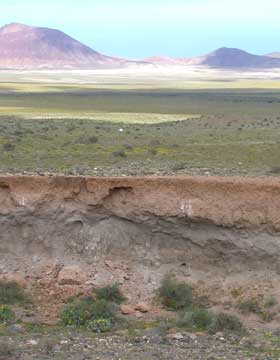|
NEWS NOTES — NEWS
Atmospheric science
African dust helps islands bloom
 Dan Muse |
| Skies clear after a dust storm on the Canary Island of Lanzarote, allowing researchers to continue analyzing the soils’ origins. Tan-colored sediment at the top is from Africa, from which the modern soil developed, while light gray sand below is from dunes of a local beach. The darker gray sediment below that is local volcanic ash. |
Dust from Africa that hitches a ride across the Atlantic Ocean on trade winds has acquired a bad reputation over the years. It is often blamed for introducing bacteria and fungi to Florida and the Caribbean, as well as causing respiratory disease in humans. A new study suggests the dust also has redeeming value: It helps build soil on some Western Atlantic islands that would otherwise lack enough fertile land for crops, including sugar cane, to thrive.
Western Atlantic islands are composed mostly of limestone, a rock that easily erodes and does not contribute to building nutrient-rich soil. As a result, just how Western Atlantic islands have become covered with rich, fertile soil has remained a mystery. Researchers have suspected that the soil’s fertility derives from several sources: impurities within the limestone that are eroded out of the rock, ash from nearby volcanic eruptions, and dust blown in from Africa. The relative contribution from each source has been uncertain, however.
Reporting April 24 in the Journal of Geophysical Research, Daniel Muhs, a soil scientist with the U.S. Geological Survey in Denver, and colleagues now say that they have nailed down those proportions. By analyzing key elements in the soil to trace its origins, they found that dust from Africa is a significant contributor to Western Atlantic island soils.
To find out where Barbados, the Florida Keys and the Bahamas get their soil, the team measured the amounts of trace elements present. The relative abundance of scandium, chromium, thorium and zirconium in the soil acts as a fingerprint, revealing where a soil originated. “It’s a geochemical analogue of a DNA signature,” Muhs says.
The team found that 60 percent of the soils in the Florida Keys and 40 percent of those in the Bahamas are African dust, Muhs says. The remaining contributions to those islands came from dust from the lower Mississippi River Valley in the United States and volcanic ash from the islands of St. Vincent, St. Lucia and Dominica. Conversely, the main source of Barbados soil came from volcanic ash from St. Vincent. Muhs says he is not entirely surprised by the results, but they confirm suspicions that Africa is indeed a large contributor and that North America also has an influence on the islands’ makeup.
The next step is to find out the geographical extent of Africa’s contribution of dust to Atlantic islands. Currently, Muhs is looking farther north, at Bermuda, to find out if soils there also have a significant African influence. There is no guarantee, however, that relative contributions today will be the same tomorrow. There can be “a lot of variability” in the source of soil, Muhs says, adding that other researchers have also noted changes in soil composition that occurred during interglacial periods, as well as simply from northern or southern shifts in trade winds. Fortunately, the U.N. Food and Agriculture Organization lists 20 countries that are major producers of sugar cane, so that commodity won’t likely disappear with the changing winds.

 Subscribe
Subscribe


